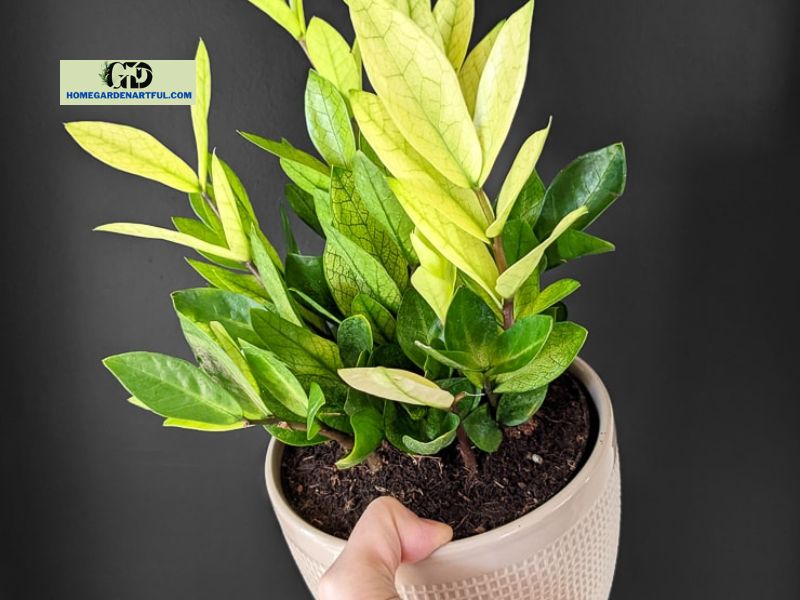Imagine a plant that develops different hues as it grows, a living work of art that gives your indoor garden a dynamic feel.
Meet the Chameleon ZZ plant, a rare type that is a sturdy companion for individuals who don’t think they have a green thumb and is a visual joy.
Homegardenartful.com will delve into the intriguing world of this plant, learning about its special characteristics, where it came from, and how to take care of it.
What Is Chameleon ZZ Plant?
A fresh and intriguing variant of the Zamioculcas zamiifolia plant family, also known as the ZZ plant, is the ZZ Chameleon plant.
The ZZ Chameleon adds a fresh twist to the family while maintaining the traditional all-green ZZ plant’s hardiness and luscious green leaves. Though it has the same hardiness as its green cousin, its leaves develop in an intriguing way as they get older.
This plant has leaves that are almost highlighter yellow in color with green veining. They harden off to a deep green as they get older. This indicates that the ZZ Chameleon plant always exhibits a lovely blend of yellow and green, giving it a distinctive appearance even though the foliage eventually turns roughly the same shade of green as the traditional ZZ plant.
It differs from other variants of ZZ plants, such as the raven ZZ plant, in that its leaves harden off to a practically pure black hue.
Is a variegated ZZ plant the same as the ZZ chameleon?
Although the word “variegated” is used to describe the plant in the ZZ chameleon patent paperwork, it is not a genuine variegated ZZ plant. While the ZZ chameleon’s leaves do show some variegation, it also has leaves that are entirely pure yellow and green.
Furthermore, the variegation is metachromatic, changing from yellow to variegated green and then from yellow to the final color of green. The leaves won’t change color after they get green.
Care for Chameleon ZZ Plant
Low light is tolerated by the Light Chameleon ZZ Plant, but it prefers — and develops more quickly, producing more colorful new growth — in an area with medium to bright, indirect light. It is best to keep this plant away from direct sunshine, especially in southern regions. The new growth may scorch if there is too much light. This striking indoor plant will thrive in both natural and artificial plant lighting.
Water
This low-water houseplant has thick, potato-like rhizomes and leaves that can store moisture, so it can go for weeks without water if necessary. In fact, after losing all of its leaves, the plant might even reappear and sprout new growth. However, given that roughly 50% of the soil dries up, we advise watering it to encourage more of the golden-yellow new leaves. Uncertain as to when to water? Usually, it is best to wait. ZZ Plants prefer a dry environment over a damp one.
Fertilizing
Although the Chameleon ZZ Plant is not an especially hungry houseplant, providing it with a steady supply of nutrients will allow you to take advantage of more of its new development. You can fertilize with water-mixable fertilizers or time-release granules, which gradually release nutrients into the soil over the course of weeks or months.
No matter what kind of fertilizer you use, you should never go over the recommended dosage. Never use more fertilizer; you can always use less.
Humidity
High humidity is not necessary for the chameleon ZZ Plant to flourish. The typical relative humidity values found in most homes and workplaces suit it just fine.
Pruning
Chameleon ZZ Plant is a low-maintenance indoor plant that only needs its old leaves to be removed as they get older.
How to grow ZZ plants in a garden
Since the ZZ chameleon is a trademarked variety, it is not permitted to multiply this plant. It is simple to divide ZZ plants at the rhizome level as well as pot them up individually, though, if you have a plant that you’d like to split for your own personal use.
Is ZZ the chameleon a sun or shade person?
It’s common to refer to ZZ plants as low-light plants. The growth is significantly slowed down by the all-green ZZ plant variety, despite the fact that it can endure reduced light levels fairly well. For the ZZ chameleon variety, indirect light that is moderate to bright is ideal.
The good news is that you can keep this plant fairly far from a window; it only needs to be in an area with continuous natural light or grow lights. Although you don’t have to place it in the brightest area of your house, it will grow the best there.
Avoid the sun’s rays, especially outside. The foliage will be burned. If you transfer the plant outdoors for the summer or if you’re fortunate enough to live somewhere that is consistently warm, place it on a covered patio or beneath a shade cloth.
How dangerous is a ZZ plant to animals?
If consumed, ZZ plants are poisonous in all parts. Although it is safe to be close to the plant and to touch its foliage, ingesting it might cause pain, a burning feeling, and swelling. Avoid biting children or pets.
I always advise putting on protective gloves when trimming or repotting the plant because the sap might be bothersome to some people.

